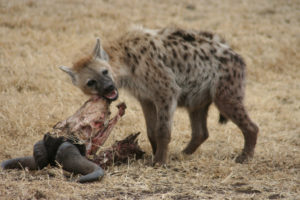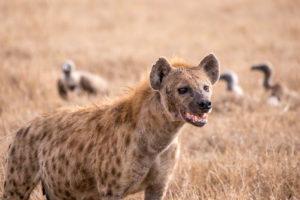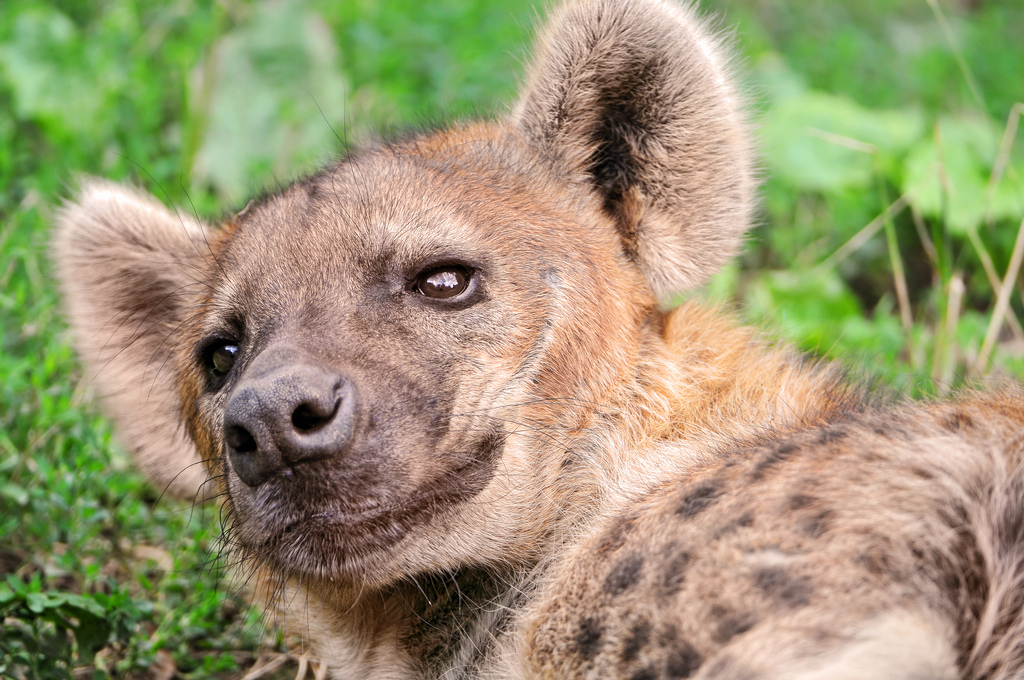Hyenas are medium dog-like carnivores. While they look somewhat like dogs, they belong to their own unique family, the Hyaenidae. They live in savannas, grasslands, forests, sub-deserts and the mountains of Africa and Asia. Take a look below for 28 more interesting and fun facts about hyenas.
1. Average hyenas live for about 12 years, while some can live up to 25 years.
2. There are 4 members of the Hyaenidae family. The first is the striped hyena, the second is the giggly spotted hyena, the third is the brown hyena and the last is the aardwolf.
3. The spotted hyena, Crocuta crocuta, is the biggest hyena species. It can grow to between 1.2 to 1.8 meters, or 4 to 5.9 feet, in length, and have a shoulder height of 77 to 81 centimeters, or 2.5 to 2.6 feet. It can weigh anywhere between 40 to 86 kilograms, or 88 to 190 pounds.
4. The brown hyena, Hyaena brunnea, is the second largest species. It can grow up to between 130 and 160 centimeters, or 51 and 63 inches, in length. It can weigh between 34 and 72.6 kilograms, or 75 and 160 pounds.
5. The aardwolf, Proteles cristata, is the smallest hyena species. It can grow up to between 85 and 105 centimeters, or 33 and 41 inches, in length, and up to one fourth of that is its tail. It can weigh anywhere between 17.6 to 30.8 pounds, or 8 to 14 kilograms.
6. Spotted hyenas are social and live in groups called clans, which can have up to 80 members.

7. Striped hyenas were thought to live solitary but have recently been recorded to live in very small groups. However, they still like to forage alone.
8. Brown hyenas were also thought to be solitary, but have recently been seen in clans of 10 members. They have also been seen foraging in a group.
9. Aardwolves live as monogamous pairs with their offspring.
10. All species are primarily nocturnal, but sometimes they like to forage and explore early in the morning.
11. Spotted hyenas kill 95% of the animals that they eat. Striped and brown hyenas tend to scavenge their food from larger predators, like lions. Aardwolves are insectivores and stick to eating termites.
12. Spotted hyenas “laugh” when they’re trying to communicate excitement or frustration. You can hear them “laughing” often when they’re hunting.
13. They mate outside of their clan. Males and females that aren’t related will make after a courtship that lasts up to 7 days.
14. Female hyenas will bear litters of 2 to 4 cubs, which will be born with their eyes open.
15. Hyena cubs will eat meat from kills that happen near the den for 5 months. However, they will still be suckled for 12 to 18 months, which is unusual for carnivores. When they’re about 2 years old, the cubs will be mature and old enough to leave their mother.

16. Female spotted hyenas are a lot more muscular and aggressive than male spotted hyenas. This is because the females have 3 times more testosterone in their bodies. Due to their size and aggressiveness, spotted hyena societies are matriarchal.
17. Even though they have a low diversity, they’re unique and vital to most African ecosystems.
18. They often fight with lions over territories and prey. They’re known to steal each other’s food and kill off each other’s offspring. The competition between lions and hyenas is the fiercest of any other animal in Africa.
19. Hyenas have been around for 24 million years.
20. The mongoose and the meerkat are the closest relatives that hyenas have.
21. Their hearts are twice as big as that of a similar sized mammal.
22. Spotted hyenas can eat up to one third of its body weight in one meal.
23. They’re known to run up to 60 kilometers, or 37 miles, per hour.

24. While it’s reputed to be cowardly and timid, they can be bold and dangerous, attacking both animals and humans.
25. Spotted and striped hyenas have been known to become man-eaters.
26. The Maasai people of Kenya and Tanzania leave their dead to be eaten by hyenas instead of burying them.
27. In Ancient Egypt, hyenas were domesticated and eaten.
28. Hyenas are viewed as frightening and worthy of contempt. They’re often associated with witchcraft because their body parts are used as ingredients in traditional medicine. In some cultures, they’re even thought to influence people’s spirits, rob graves and steal livestock and children.





One Comment
Pingback:
February 4, 2018 at 5:51 pm